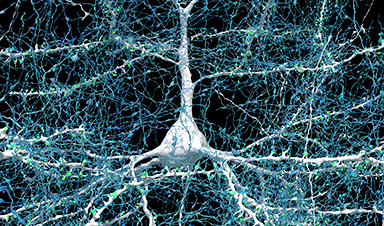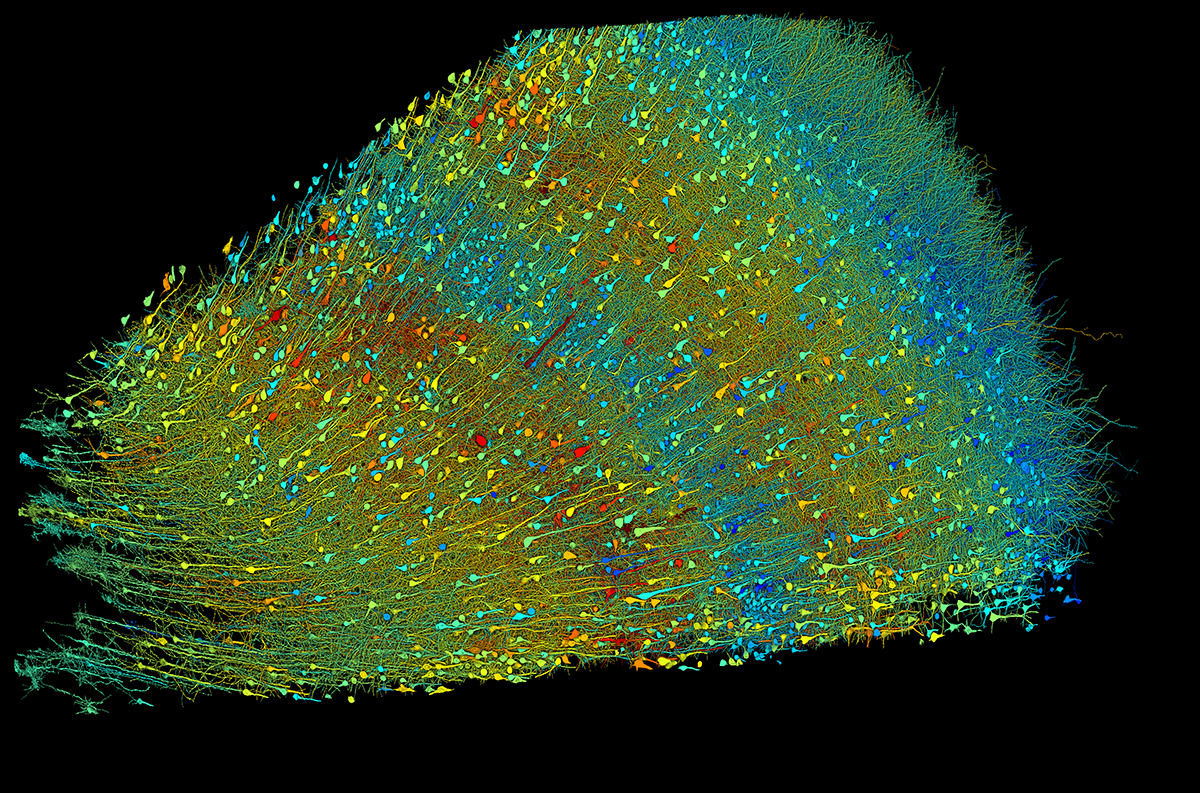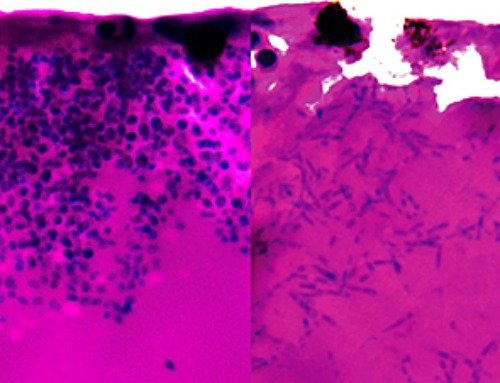Fully understanding how the human brain works requires knowing the relationships between the various cells that make up the brain. This entails visualizing the brain’s structure on the scale of nanometers in order to see the connections between neurons.
A team of researchers, led by Dr. Jeff Lichtman at Harvard University and Dr. Viren Jain at Google Research, used electron microscopy (EM) to image a cubic millimeter-sized piece of human brain tissue at high resolution. The tissue was removed from the cerebral cortex of a patient as part of a surgery for epilepsy.
The team began by cutting the tissue into more than 5,000 slices, or sections, each of which was then imaged by EM. This yielded about 1.4 petabytes, or 1,400 terabytes, of data. Using these data, the researchers generated a 3D reconstruction of almost every cell in the sample. Results of the NIH-funded study appeared in Science on May 10, 2024.
Analysis of individual cells in the sample revealed a total of more than 57,000 cells. Most of these were either neurons, which send electrical signals, or glia, which provide various support functions to the neurons. Glia outnumbered neurons 2-to-1. The most common glial cells were oligodendrocytes, which provide structural support and electrical insulation to neurons. The one cubic mm sample also contained about 230 mm of blood vessels.
The reconstruction revealed structural details not seen before. The researchers analyzed a type of neuron, called triangular cells, that are found in the deepest layer of the cerebral cortex. Many of these adopted one of two orientations, which were mirror images of each other. The significance of this organization remains unknown.
The team used machine learning to identify synapses—the junctions through which signals pass from one cell to another. They found almost 150 million synapses. Almost all neurons formed only one synapse with a given target cell. But a small fraction formed two or more synapses to the same target. In at least one case, more than 50 synapses connected a single pair of cells. Although rare, connections of seven or more synapses between cells were much more common than expected by chance. This suggests that these strong connections have some functional significance.
The results illustrate just how complex the brain is at the cellular level. They also show the value of connectomics—the science of generating comprehensive maps of connections between brain cells—for understanding brain function.
“The word ‘fragment’ is ironic,” Lichtman says. “A terabyte is, for most people, gigantic, yet a fragment of a human brain—just a miniscule, teeny-weeny little bit of human brain—is still thousands of terabytes.”
The team has made their dataset available to the public. They have also provided various software tools to help examine the brain map. The hope is that further study of the data, by this team and others, will yield new insight into the workings of the human brain.
“This incredible advancement—the ability to capture and process over 1,000 terabytes of data from the brain—wouldn’t have been possible without a study participant’s generous donation and the important partnerships between neuroscientists, computer scientists, and engineers,” says Dr. John Ngai, director of NIH’s BRAIN Initiative. “These collaborations are central in our aim of building a full map of the human brain so we can bring cures closer to the clinic.”
—by Brian Doctrow, Ph.D.
News
Scientists Unlock a New Way to Hear the Brain’s Hidden Language
Scientists can finally hear the brain’s quietest messages—unlocking the hidden code behind how neurons think, decide, and remember. Scientists have created a new protein that can capture the incoming chemical signals received by brain [...]
Does being infected or vaccinated first influence COVID-19 immunity?
A new study analyzing the immune response to COVID-19 in a Catalan cohort of health workers sheds light on an important question: does it matter whether a person was first infected or first vaccinated? [...]
We May Never Know if AI Is Conscious, Says Cambridge Philosopher
As claims about conscious AI grow louder, a Cambridge philosopher argues that we lack the evidence to know whether machines can truly be conscious, let alone morally significant. A philosopher at the University of [...]
AI Helped Scientists Stop a Virus With One Tiny Change
Using AI, researchers identified one tiny molecular interaction that viruses need to infect cells. Disrupting it stopped the virus before infection could begin. Washington State University scientists have uncovered a method to interfere with a key [...]
Deadly Hospital Fungus May Finally Have a Weakness
A deadly, drug-resistant hospital fungus may finally have a weakness—and scientists think they’ve found it. Researchers have identified a genetic process that could open the door to new treatments for a dangerous fungal infection [...]
Fever-Proof Bird Flu Variant Could Fuel the Next Pandemic
Bird flu viruses present a significant risk to humans because they can continue replicating at temperatures higher than a typical fever. Fever is one of the body’s main tools for slowing or stopping viral [...]
What could the future of nanoscience look like?
Society has a lot to thank for nanoscience. From improved health monitoring to reducing the size of electronics, scientists’ ability to delve deeper and better understand chemistry at the nanoscale has opened up numerous [...]
Scientists Melt Cancer’s Hidden “Power Hubs” and Stop Tumor Growth
Researchers discovered that in a rare kidney cancer, RNA builds droplet-like hubs that act as growth control centers inside tumor cells. By engineering a molecular switch to dissolve these hubs, they were able to halt cancer [...]
Platelet-inspired nanoparticles could improve treatment of inflammatory diseases
Scientists have developed platelet-inspired nanoparticles that deliver anti-inflammatory drugs directly to brain-computer interface implants, doubling their effectiveness. Scientists have found a way to improve the performance of brain-computer interface (BCI) electrodes by delivering anti-inflammatory drugs directly [...]
After 150 years, a new chapter in cancer therapy is finally beginning
For decades, researchers have been looking for ways to destroy cancer cells in a targeted manner without further weakening the body. But for many patients whose immune system is severely impaired by chemotherapy or radiation, [...]
Older chemical libraries show promise for fighting resistant strains of COVID-19 virus
SARS‑CoV‑2, the virus that causes COVID-19, continues to mutate, with some newer strains becoming less responsive to current antiviral treatments like Paxlovid. Now, University of California San Diego scientists and an international team of [...]
Lower doses of immunotherapy for skin cancer give better results, study suggests
According to a new study, lower doses of approved immunotherapy for malignant melanoma can give better results against tumors, while reducing side effects. This is reported by researchers at Karolinska Institutet in the Journal of the National [...]
Researchers highlight five pathways through which microplastics can harm the brain
Microplastics could be fueling neurodegenerative diseases like Alzheimer's and Parkinson's, with a new study highlighting five ways microplastics can trigger inflammation and damage in the brain. More than 57 million people live with dementia, [...]
Tiny Metal Nanodots Obliterate Cancer Cells While Largely Sparing Healthy Tissue
Scientists have developed tiny metal-oxide particles that push cancer cells past their stress limits while sparing healthy tissue. An international team led by RMIT University has developed tiny particles called nanodots, crafted from a metallic compound, [...]
Gold Nanoclusters Could Supercharge Quantum Computers
Researchers found that gold “super atoms” can behave like the atoms in top-tier quantum systems—only far easier to scale. These tiny clusters can be customized at the molecular level, offering a powerful, tunable foundation [...]
A single shot of HPV vaccine may be enough to fight cervical cancer, study finds
WASHINGTON -- A single HPV vaccination appears just as effective as two doses at preventing the viral infection that causes cervical cancer, researchers reported Wednesday. HPV, or human papillomavirus, is very common and spread [...]






















